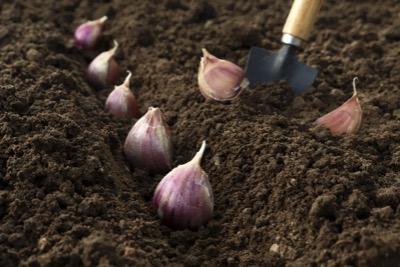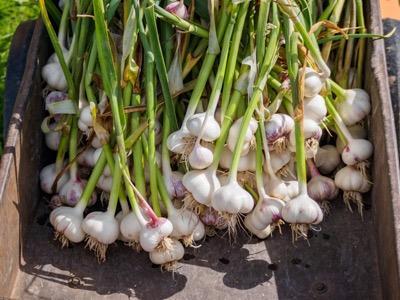Planting and cultivating garlic
When to plant
 Garlic can be planted in spring and autumn. For autumn planting, the best method is to plant the cloves in ridges to prevent them from getting too wet in winter. In spring, February / March are the ideal planting months, as the bulbs like to develop at temperatures between 5 and 10 degrees. To prevent diseases from passing along with the planting material, we give it a warm water treatment. Our planting material has been inspected by the NAK-T (Dutch General Inspection Service for Horticulture) and the SKAL (Alternative Farming Inspection Foundation).
Garlic can be planted in spring and autumn. For autumn planting, the best method is to plant the cloves in ridges to prevent them from getting too wet in winter. In spring, February / March are the ideal planting months, as the bulbs like to develop at temperatures between 5 and 10 degrees. To prevent diseases from passing along with the planting material, we give it a warm water treatment. Our planting material has been inspected by the NAK-T (Dutch General Inspection Service for Horticulture) and the SKAL (Alternative Farming Inspection Foundation).
How to plant
Use the loose cloves of the garlic bulbs as planting material. The garlic breaks apart best when it's warmed up and dry. The soil should be well loosened and not fertilized too richly. Loamy and sandy soils are ideal. Soil that is too acidic produces poor results. For the garlic bed, choose a warm spot with plenty of sun and press the cloves into the soil at a distance of 10 cm so that the tip is just visible. If you plant several rows next to each other, keep a distance of 20 cm between the rows.
Influence of the weather
After planting in the autumn, the roots will develop for the winter. After the winter, the cloves need some warmth and sun, so that the clove clones and makes small cloves. And they especially need dry weather during the ripening period. If the weather is bad and the summer remains wet and cold, the bulb remains small and sometimes don't form cloves. But if the summer is good, you can expect a great harvest of large garlic bulbs. Rot can spread especially in rainy conditions, as the spore’s splash up because of the rain. Clean planting material and good hygiene are important to prevent rot.








